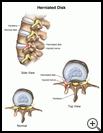
Degenerative Disk Disease
What is degenerative disk disease?
Disks are small, circular cushions between the bones of the spine (vertebrae). Normally, disks act as shock absorbers to cushion the bones in your spine from each other as you move. As you get older, the disk first develops small tears, then becomes unstable, and later hardens. Degenerative disk disease happens over several years.
Complications of degenerative disk disease may include:
- Herniated disk (also called a ruptured disk): A disk that has bulged out from its proper place when the soft, rubbery center of the disk squeezes out through a weak point in the hard outer layer. It may press on nearby nerves and cause severe pain.
- Spinal stenosis: A narrowing of the channel in the spine that surrounds the spinal cord and the nerves that branch out from the spinal cord. This puts pressure on the spinal cord and nerves and causes pain, numbness, or weakness below the area of pressure.
What can I expect in the hospital?
You may need to stay in the hospital because you have a complication of degenerative disk disease which has caused loss of bladder or bowel control, difficulty in moving your legs, or numbness or tingling in your arms or legs. You may also need to stay in the hospital if you have severe pain that is not controlled with treatment.
Several things may be done while you are in the hospital to monitor, test, and treat your condition. They include:
Monitoring
- You will be checked often by the hospital staff.
- Your heart rate, blood pressure, and temperature will be checked regularly.
- Your strength, range of motion, and ability to feel pain will be checked regularly.
- You may have a small tube (catheter) placed into your bladder to drain and measure urine.
Testing
Testing may include:
- X-rays: Pictures of the inside of the back to check for problems with the spine
- Magnetic resonance imaging (MRI): A powerful magnetic field and radio waves are used to take pictures from different angles to show thin cross sections of the spine.
- Computed tomography (CT) scan: A series of X-rays is taken from different angles and arranged by a computer to show thin cross sections of the spine.
- Electromyography (EMG): A test uses very thin needles or wires placed into a muscle to measure the electrical activity of the muscle.
- Myelography: A series of X-rays is taken after injection of contrast dye into the fluid around your spinal cord to show the spinal cord, nerves, and blood vessels around the spinal cord.
- Discography: An X-ray is taken after an injection of contrast dye into a disk in your spine to check for the cause of back or neck pain.
- Bone scan: A series of detailed pictures is taken after your healthcare provider injects a small amount of radioactive chemical into your blood. The scan shows any areas of bone where the radioactive material is being absorbed.
Treatment
The treatment for degenerative disk disease depends on your symptoms, complications, and how well you respond to treatment.
- You will have a small tube (IV catheter) inserted into a vein in your hand or arm. This will allow for medicine to be given directly into your blood and to give you fluids, if needed.
- Your provider may prescribe medicine to:
- Reduce swelling
- Treat pain
- Relax muscles in the back
- Help you sleep
- Treat or prevent side effects, such as nausea or constipation, from other treatments
- Your provider may recommend other types of therapy to help relieve pain, other symptoms, or side effects of treatment.
- You may be placed in traction, which is the process of putting bones or muscles under tension with a system of weights and pulleys to keep them from moving or to relieve pressure on them.
- You may receive physical therapy to help strengthen your muscles and learn to move in ways that do not cause more pain.
- If your back pain is not getting better with treatment or you have bowel or bladder problems, you may need surgery to reduce pressure on the disk or stabilize the spine. Surgery may include:
- Facetectomy: Surgery to remove spine joints to reduce pressure on nerves
- Foraminotomy: Surgery to widen the opening where the nerve leaves the vertebra
- Laminotomy: Surgery to widen the opening of the bone that surround and protect the spinal cord
- Laminectomy: Surgery to remove a part of the vertebrae which may be pressing on the spinal cord
- Spinal fusion: Surgery to stabilize the bones in the spine with a piece of bone or ceramic, which is held in place with plates, screws, or rods. Spinal fusion may be done with:
- Discectomy: Surgery to remove all or part of a disk which may be pressing on a nerve
- Corpectomy: Surgery to remove an entire vertebra which may be squeezing the disk. Your surgeon may replace this disk with an artificial disk
What can I do to help?
- You will need to tell your healthcare team if you have new or worsening:
- Numbness, tingling, pain, or weakness in one or both legs
- Trouble with muscle movements, such as moving your legs
- Changes in bladder and bowel control
- Inability to straighten your neck or back without severe pain
- Redness, swelling, pain, warmth, or drainage from your surgical wound
- Fever, chills, or muscle aches
- Ask questions about any medicine or treatment or information that you do not understand.
How long will I be in the hospital?
How long you stay in the hospital depends on many things, such as your general health, why you are in the hospital, and the treatment you need. Talk with your provider about how long your stay may be.
Last modified: 2016-03-30
Last reviewed: 2015-12-21

